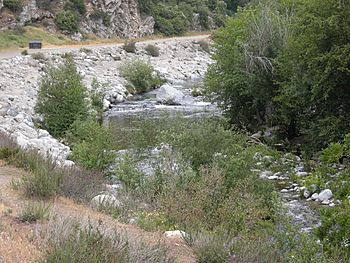West Fork San Gabriel River facts for kids
Quick facts for kids West Fork San Gabriel River |
|
|---|---|
 |
|
|
Location of the West Fork in California
|
|
| Country | United States |
| State | California |
| Physical characteristics | |
| Main source | Red Box Gap Angeles National Forest 4,530 ft (1,380 m) 34°15′29″N 118°06′13″W / 34.25806°N 118.10361°W |
| River mouth | San Gabriel River San Gabriel Reservoir 1,473 ft (449 m) 34°14′23″N 117°51′24″W / 34.23972°N 117.85667°W |
| Length | 19 mi (31 km) |
| Basin features | |
| Basin size | 104 sq mi (270 km2) |
The West Fork San Gabriel River is an important stream in Los Angeles County, California. It is one of two main streams that come together to form the larger San Gabriel River. This river flows through beautiful mountain areas.
Contents
About the West Fork San Gabriel River
The West Fork is about 19 miles (31 km) long. It starts high up in the San Gabriel Mountains at a place called Red Box Gap. From there, it flows towards the east.
Where Does the River Flow?
The river's journey ends at the San Gabriel Reservoir. This is a large lake created by the dam. A road called SR 39 crosses the river just before it reaches the reservoir.
What Other Streams Join It?
As the West Fork flows, other smaller streams join it. These are called tributaries. Some of the main ones are Devil Creek, Bear Creek, and the North Fork San Gabriel River. These streams add more water to the West Fork.
Important Features of the River
A big part of the area around the West Fork is in the San Gabriel Wilderness. This is a special protected area where nature is kept wild. The West Fork forms the southern edge of this wilderness.
Cogswell Dam and Reservoir
One important feature on the river is the Cogswell Dam. This dam creates the Cogswell Reservoir, which holds about 10,785-acre-foot (13,303,000 m3) of water. The dam helps control floods and stops too much dirt and mud from flowing into the San Gabriel Valley.
Home for Wildlife
The West Fork San Gabriel River is a special place for wildlife. It is a safe home for wild rainbow trout in Southern California. These fish need clean, cool water to live and thrive.


